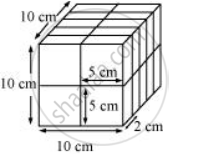Advertisements
Advertisements
प्रश्न
Parikshit makes a cuboid of plasticine of sides 5cm, 2cm, 5cm. How many such cuboids will he need to form a cube?
उत्तर
Here, some cuboids of size 5 × 2 × 5 are given.

When these cuboids are arranged to form a cube, the side of this cube so formed will be a common multiple of the sides (i.e., 5, 2, and 5) of the given cuboid.
LCM of 5, 2, and 5 = 10
Let us try to make a cube with a 10 cm side.
For this arrangement, we have to put 2 cuboids along with its length, 5 along with its width, and 2 along with its height.
Total cuboids required according to this arrangement: 2 × 5 × 2 = 20
With the help of 20 cuboids of such measures, a cube is formed as follows:

Alternatively
Volume of the cube on sides: 5cm, 2cm, 5cm
= 5cm × 2cm × 5cm = (5 × 5 × 2) cm3
Here, two 5s and one 2 are left that are not in a triplet.
If we multiply this expression by 2 × 2 × 5 = 20, then it will become a perfect cube.
Thus, (5 × 5 × 2 × 2 × 2 × 5) = (5 × 5 × 5 × 2 × 2 × 2) = 1000 is a perfect cube.
Hence, 20 cuboids of 5cm, 2cm, and 5cm are required to form a cube.
APPEARS IN
संबंधित प्रश्न
Find the smallest number by which the following number must be divided to obtain a perfect cube.
135
Find the smallest number by which the following number must be divided to obtain a perfect cube.
704
Which of the following is perfect cube?
64
Which of the following is perfect cube?
166375
What is the smallest number by which the following number must be multiplied, so that the products is perfect cube?
35721
By which smallest number must the following number be divided so that the quotient is a perfect cube?
35721
Which of the following number is cube of negative integer - 1056 .
Find the cube root of the following natural number 1157625 .
Show that:
\[\frac{\sqrt[3]{729}}{\sqrt[3]{1000}} = \sqrt[3]{\frac{729}{1000}}\]
Find the cube-root of -64 x -125
